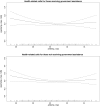Help-seeking behavior during elevated temperature in Chinese population
- PMID: 21761264
- PMCID: PMC3157502
- DOI: 10.1007/s11524-011-9599-9
Help-seeking behavior during elevated temperature in Chinese population
Abstract
The negative impact of extreme temperatures on health is well-established. Individual help-seeking behavior, however, may mitigate the extent of morbidity and mortality during elevated temperatures. This study examines individual help-seeking behavior during periods of elevated temperatures among a Chinese population. Help-seeking patterns and factors that influence behavior will be identified so that vulnerable subgroups may be targeted for health protection during heat crises. A retrospective time-series Poisson generalized additive model analysis, using meteorological data of Hong Kong Observatory and routine emergency help call data from The Hong Kong Senior Citizen Home Safety Association during warm seasons (June-September) 1998-2007, was conducted. A "U"-shaped association was found between daily emergency calls and daily temperature. About 49% of calls were for explicit health-related reasons including dizziness, shortness of breath, and general pain. The associate with maximum temperature was statistically significant (p = 0.034) with the threshold temperature at which the frequency of health-related calls started to increase being around 30-32°C. Mean daily relative humidity (RH) also had a significant U-shaped association with daily emergency health-related calls with call frequency beginning to increase with RH greater than 70-74% (10-25% of the RH distribution). Call frequency among females appeared to be more sensitive to high temperatures, with a threshold between 28.5°C and 30.5°C while calls among males were more sensitive to cold temperatures (threshold 31.5-33.5°C). Results indicate differences in community help-seeking behavior at elevated temperatures. Potential programs or community outreach services might be developed to protect vulnerable subgroups from the adverse impact of elevated temperatures.
Figures








Similar articles
-
A study of intracity variation of temperature-related mortality and socioeconomic status among the Chinese population in Hong Kong.J Epidemiol Community Health. 2012 Apr;66(4):322-7. doi: 10.1136/jech.2008.085167. Epub 2010 Oct 25. J Epidemiol Community Health. 2012. PMID: 20974839 Free PMC article.
-
Short-term association between ambient temperature and acute myocardial infarction hospitalizations for diabetes mellitus patients: A time series study.PLoS Med. 2018 Jul 17;15(7):e1002612. doi: 10.1371/journal.pmed.1002612. eCollection 2018 Jul. PLoS Med. 2018. PMID: 30016318 Free PMC article.
-
Hospital admissions as a function of temperature, other weather phenomena and pollution levels in an urban setting in China.Bull World Health Organ. 2013 Aug 1;91(8):576-84. doi: 10.2471/BLT.12.113035. Epub 2013 May 31. Bull World Health Organ. 2013. PMID: 23940405 Free PMC article.
-
The influence of cold weather on the usage of emergency link calls: a case study in Hong Kong.BMC Med Inform Decis Mak. 2015 Aug 13;15:66. doi: 10.1186/s12911-015-0191-1. BMC Med Inform Decis Mak. 2015. PMID: 26590158 Free PMC article.
-
High temperatures and nephrology: The climate change problem.Nefrologia. 2017 Sep-Oct;37(5):492-500. doi: 10.1016/j.nefro.2016.12.008. Nefrologia. 2017. PMID: 28946962 Review. English, Spanish.
Cited by
-
Effects of ambient temperature on ambulance emergency call-outs in the subtropical city of Shenzhen, China.PLoS One. 2018 Nov 12;13(11):e0207187. doi: 10.1371/journal.pone.0207187. eCollection 2018. PLoS One. 2018. PMID: 30419000 Free PMC article.
-
The effect of ambient temperature on type-2-diabetes: case-crossover analysis of 4+ million GP consultations across England.Environ Health. 2017 Jul 12;16(1):73. doi: 10.1186/s12940-017-0284-7. Environ Health. 2017. PMID: 28701216 Free PMC article.
-
The development of the Hong Kong Heat Index for enhancing the heat stress information service of the Hong Kong Observatory.Int J Biometeorol. 2016 Jul;60(7):1029-39. doi: 10.1007/s00484-015-1094-7. Epub 2015 Nov 6. Int J Biometeorol. 2016. PMID: 26546311
-
Suitable temperature indicator for adverse health impacts in sub-tropical cities: a case study in Hong Kong from 2010-2019.Int J Biometeorol. 2025 Jan;69(1):233-244. doi: 10.1007/s00484-024-02807-1. Epub 2024 Oct 30. Int J Biometeorol. 2025. PMID: 39476018 Free PMC article.
-
The effect of temperature on physical activity: an aggregated timeseries analysis of smartphone users in five major Chinese cities.Int J Behav Nutr Phys Act. 2022 Jun 14;19(1):68. doi: 10.1186/s12966-022-01285-1. Int J Behav Nutr Phys Act. 2022. PMID: 35701809 Free PMC article.
References
Publication types
MeSH terms
LinkOut - more resources
Full Text Sources
Miscellaneous

